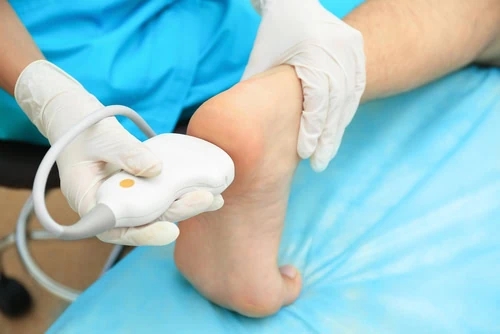
Stabbing heel pain is one of the most common foot complaints. There can be a multitude of reasons for such pain, but the most frequent cause is plantar fasciitis. Plantar fasciitis is a name most are familiar with. However, in this blog, you will see me use the proper name, plantar fasciocis. This may come to a shock for some, but there is the potential you may be misdiagnosed because of a nerve problem that is frequently overlooked by health professionals. As you scroll through this blog, I will dive deeper into plantar fasciocis, pain, treatments, and supporting research.
Plantar Fasciitis
This is the pain that frequently catches your attention when getting out of bed in the morning. Your heel makes an impact with the ground, and the first steps out of bed are painful. But, after a few minutes, the pain typically fades. So why the heel? Well, this is where the fascia connects to the heel bone, extending out into the ball of your foot. Most misunderstand plantar fasciitis as a tendon or a ligament, when in fact, by true definitions, it is tight connective tissue.
What Causes Plantar fasciitis?
With every step you take, the fascia is stretched and pulled from your heel creating tension. Children and teenagers seldom have plantar fasciitis, as their fascia is flexible and stretches rather than pulls from the heel.
Treatments
When it comes to pain, there are a multitude of treatments which include home remedies. Icing, anti-inflammatories, night splints, stretching exercises, supportive shoes, arch supports, and ice packs. These all may be helpful if used in the early stages of your heel pain, as they can potentially assist in reducing the tension of fascia in the heel. More often than not, these home remedies can be successful in self-management of your pain, but with only partial improvement – leaving you with unresolved symptoms.
The Real Problem That No One is Talking About
Science says your fascia is not inflamed, but rather it’s the tissue that is deteriorating. I want to briefly make a bold and averse statement: doctors aren’t looking at science. Doctor Harvey Lemont did a study taking fifty plantar fascia specimens when he performed surgery for plantar fasciitis 1. Out of 50 specimens, only one came back showing inflammatory changes. The other 49 showed the tissue was deteriorating, thus creating the term plantar fasciocis 1.
How Does that Change Treatments?
Home remedies may still be used, but because we now know that the tissue is inflamed, this explains why the pain is so persistent. Using ice, anti-inflammatory medication, or cortisone injections may not have high success rates. Unfortunaltey, many podiatrists continue to recommend cortisone injections offering only temporary relief.
Regenerative Medicine
At Anderson Podiatry Center, we started using regenerative medicine to repair damaged fascia tissue over 13 years ago. We were one of the early pioneers of this technique, and we now use human cellular tissue products such as placenta cells or umbilical cord fluids to repair fascia. We find this far more successful than cortisone.
Supporting the Foot
Yes, podiatrists recommend custom orthotics specifically made for your foot type to reduce the pulling of the fascia from your heel with each step you take.
Nerve Pain
This is the hidden problem that can mimic plantar fasciitis. There is a small nerve branch that comes from a region of the foot and ankle called the tarsal tunnel, just like carpal tunnel in the hand. The nerve going through this region travels to the bottom of the foot, into the arch and toes. Within the ankle region, a small branch travels beneath the heel from the ankle area called the medial calcaneal nerve. So, how is this treated? Typically, a series of two cortisone injections can reverse this type of heel pain. Additionally, a laser can also be effective.
How Do WE Know What You Have?
 To begin, every patient we see with heel pain has an ultrasound examination of their heel. We know what the normal appearance of fascia should be by immense studies that have been performed. Generally, a patient with plantar fascia pain will have a thicker and darker appearing fascia in the area where it attaches to the heel bone. A diagnostic ultrasound is extremely useful to ensure that your pain is truly from fascia. If the fascia looks normal, we will then suspect the nerve problem.
To begin, every patient we see with heel pain has an ultrasound examination of their heel. We know what the normal appearance of fascia should be by immense studies that have been performed. Generally, a patient with plantar fascia pain will have a thicker and darker appearing fascia in the area where it attaches to the heel bone. A diagnostic ultrasound is extremely useful to ensure that your pain is truly from fascia. If the fascia looks normal, we will then suspect the nerve problem.
Can You Have Plantar Fasciitis and Nerve Pain?
Yes, it is not uncommon from our clinical examination and diagnostic ultrasound to discover both. It is thought that the thicker the fascia becomes, the more likely the nerve may become irritated.
Summary
So, this may mean for you that if you’ve had many of the conservative treatments for plantar fasciitis, and you still have that sharp stabbing heel pain, your nerve may be the issue. If you are having stabbing pain in the heel of your foot, don’t assume it’s always going to be plantar fasciitis. You could be having nerve pain. And finally, understand that your heel pain may be from a fascia that is deteriorating (plantar fasciosis) and not inflamed. This gives you a whole new way of looking at the problem and a possible solution that could be the use of regenerative medicine!
References
1 Lemont, H., Ammirati, K. M., & Usen, N. (2003). Plantar fasciitis: a degenerative process (fasciosis) without inflammation. Journal of the American Podiatric Medical Association, 93(3), 234–237. https://doi.org/10.7547/87507315-93-3-234


